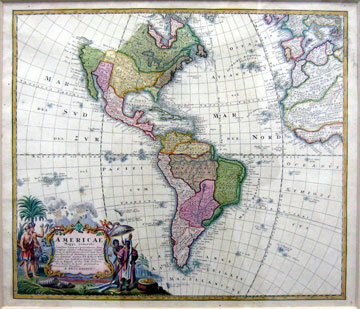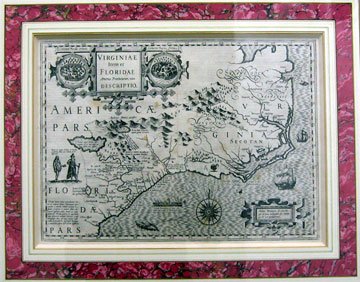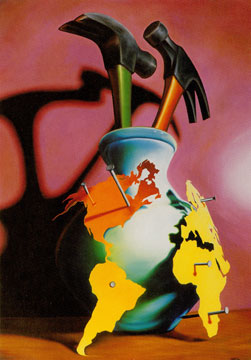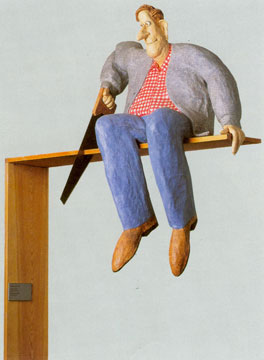

| For more information about this article or gallery, please call the gallery phone number listed in the last line of the article, "For more info..." |
January Issue
2009
Burroughs-Chapin
Art Museum in Myrtle Beach, SC, Presents Exhibit on Mapmaking
and Exhibit of Tools
The Franklin G. Burroughs-Simeon B. Chapin Art Museum in Myrtle Beach, SC, will present several new exhibits including, The Mapmakers' Art: The Bishop Collection of Antique Maps: 1608-1863, which will be on view from Jan. 4 through Mar. 20, 2009 and Tools in Motion: Works from the Hechinger Collection, on view from Jan 15 through Mar. 28, 2009.
 Johann Baptist Homann
Johann Baptist Homann
Following the discovery of the New World in the 15th century, European mapmakers scrambled to document and map the new territories, using centuries-old technology. In contrast to today's mass-produced, utilitarian maps, early European cartographers recruited renowned painters and miniaturists of their times who created maps that were truly works of art, richly colored and intricately decorated.
The Museum will display a collection of these magnificent works in an exhibit titled The Mapmakers' Art: The Bishop Collection of Antique Maps: 1608-1863. The artworks, a 1999 gift from Mrs. George Bishop in memory of her late husband, a local entrepreneur, are part of the Museum's permanent collection.
 Willem Janzoon Blaeu
Willem Janzoon Blaeu
The exhibit includes 15 maps illustrating what has been termed the golden age of cartography plus a selection of complementary historical prints. During that era of rapid discovery - and hence, extensive production of new maps - cities as far-flung as Paris, Amsterdam, Florence, Venice and London competed as mapmaking centers of the world.
Since early maps often relied on unverified and often unreliable information from native populations, unsubstantiated reports and hearsay, the maps illustrate the evolution of both exploration and documentation of geographical information.
Among the historic gems included in the collection is An Accurate Map of North and South Carolina by Henry Mouzon, an enormous copperplate engraving of four joined sheets created in 1775. The earliest map in the collection, produced in 1606 by Gerard Mercator and engraver Jodocus Hondius, was based on a 1590 map of Virginia and a 1591 map of Florida. The 1825 map of Horry District by Robert Mills, considered the first American architect, and a map created by naturalist Mark Catesby for his celebrated 1731 work A Natural History of Carolina, Florida and the Bahama Islands are other highlights.
Among the historical prints accompanying the maps are four Civil War scenes from Harper's Weekly and a collection of steel engravings from The Portrait Gallery of Eminent Americans, published in 1863, which include our country's founding fathers.
 Ron English
Ron English
The exhibit, Tools
in Motion: Works from the Hechinger Collection, is comprised
of 56 witty, light-hearted works by prominent and emerging contemporary
artists that celebrate these utilitarian objects. The collection
is drawn from Tools as Art: The Hechinger Collection, amassed
by a former DC-based hardware and building-supply company owner
who began collecting the artworks in 1978 to decorate the family
business. Spanning a wide range of styles, the exhibition spotlights
the dignity of everyday tools where form and function are inextricably
linked.
 Stephen Hansen
Stephen Hansen
The clever content and style and visually intriguing works will
prove thought-provoking for visitors of all ages, allowing them
to explore new art and introducing them to important contemporary
artists, such as Arman, Claes Oldenburg and Jim Dine.Through the
hands and the vision of the artists, common utilitarian objects
take on a whole new existence. The works offer such mind-bending
visual experiences as an image of a man happily sawing himself
off a high perch or a huge "school" of vise grips swimming
in the ocean. Light bulbs are transformed into butterflies and
rusted tools morph into birds or the sails of a wooden boat.
 Maria Josephy
Maria Josephy
The collection features a series of "kodaliths" by acclaimed designer Ivan Chermayeff: striking black and white photographs with no halftones that display various hardware items in an almost abstract fashion. Also included is Tool Box, a set of silkscreen prints by renowned artist Jim Dine, which juxtapose real and invented objects in a playful blurring of art and life.
The Franklin G. Burroughs-Simeon B. Chapin Art Museum is a wholly nonprofit institution located across from Springmaid Pier. Components of Museum programs are funded in part by support from the City of Myrtle Beach, the Horry County Council and the South Carolina Arts Commission, which receives support from the National Endowment for the Arts.
For further information
check our SC Institutional Gallery listings, call the Museum at
843/238-2510 or visit (www.MyrtleBeachArtMuseum.org).
Carolina Arts is published monthly by Shoestring Publishing Company, a subsidiary of PSMG, Inc. Copyright© 2009 by PSMG, Inc., which published Charleston Arts from July 1987 - Dec. 1994 and South Carolina Arts from Jan. 1995 - Dec. 1996. It also publishes Carolina Arts Online, Copyright© 2009 by PSMG, Inc. All rights reserved by PSMG, Inc. or by the authors of articles. Reproduction or use without written permission is strictly prohibited. Carolina Arts is available throughout North & South Carolina.